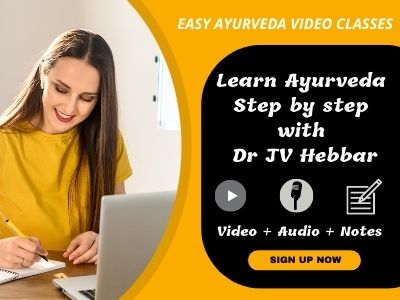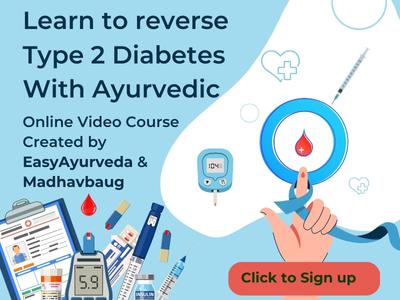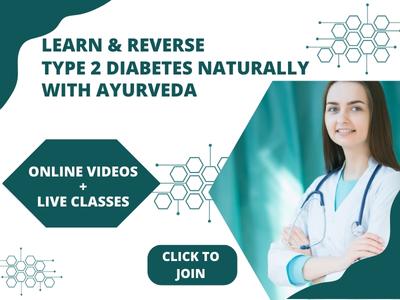This article explains Sushruta Samhita Sutrasthana Chapter 5 “Agropaharaniya Adhyaya”- Collection of materials.
Agropaharaniya Adhyaya
We will now expound the chapter by name Agropharaniya – collection of important materials (required for surgical operation), as revealed by the venerable Dhanvantari.
Trividha Karma
Three kinds of procedures
Activities (surgical activities) or procedures are of three kinds viz –
- Purva karma – early activities (procedures done before the main surgery, preparation of the patient etc) – pre-procedures
- Pradhana Karma – main activities (main procedure or the surgery conducted on the patient) – procedures
- Paschat Karma – later activities (procedures done / implemented after the main surgical process) – post-procedures / post-operative procedures & follow up.
Read – Chikitsa: Treatment Types, Ayurvedic classification
We will describe these in respect of each disease later on
Note – Purva, Pradhana and Pascat Karma are applicable for any treatment or therapy. Karma means activity. Treatment is also an activity. Surgery is the main treatment procedure in Salya Tantra i.e., surgical science and hence this is the main activity here.
Surgical procedures are the most important interventions in Salya Tantra (surgery)
In this science (Shalya Tantra / Surgery), Sastra Karma (surgical activities) itself being the main, only Sastra Karmas (surgical techniques) shall be described first including the materials required for it.
Read – Methods Of Surgical Training Elaborated In Ayurveda
Notes: – The three stages mentioned above are applicable to all the activities.
Purva Karma (pre or early activities) – are those which are necessarily required for the proper conduct of the main activity (medicinal treatment of surgery) i.e., “preparation”.
Pradhana Karma (main activities) – are those which are the main activities which are essentially planned to be conducted i.e., “the execution”. This is the actual procedure to be conducted – the treatment / procedure proper.
Paschat Karma (later activities) – are those which are done after the main activity has been completed i.e., “the follow up”.
In surgical science, these three stages are known as preoperative, operative and postoperative activities.
In the context of Kaya Cikitsa (internal or general medicine) while describing Shodhana Karma (purificatory therapies such as emesis. purgation etc.), administration of snehana (oleation) and swedana (sudations) are called Purva Karma (preparatory activity). Administration of purificatory recipes (emetic, purgative etc) and management of the patient till satisfactory purifications are achieved are called Pradhana Karma (main activity). Taking care of the patient by providing him nursing, comforts, suitable foods, rest etc. after the completion of the main activity are called Pascat Karma (protective activity / follow up activity).
Read – 4 Types Of Swedana As Per Sushruta And Vagbhata
Astha Vida Sastra Karma
Eight kinds of surgical techniques
Sastra Karma – Surgical activity (techniques) are eight kinds viz,
- Chedya – incising, excising, removing
- Bhediya – splitting, dividing, separating
- Lekhya – scraping
- Vedhya – puncturing, piercing
- Esya – probing, searching
- Aharya – extracting, pulling out, removing
- Visravya – draining and
- Sivya – sewing suturing
Read – Sushruta’s 8 Types Of Surgical Procedures – Astavidha Shastra Karma
1. Purva Karma – Pre-operative activities
Agro Maharana-collection of Materials required
The physician (surgeon) desirous of performing any of these activities should collect the required materials beforehand. This is called as agra sangrahana i.e., beforehand collection (collection beforehand) of materials. The important materials which need to be collected are –
| Sl No | Agra Sangrahaniya (Materials to be collected) | Meaning |
| 1 | Yantra | Blunt instruments |
| 2 | Sastra | Sharp instruments |
| 3 | Ksara | Caustic alkali |
| 4 | Agni | Fire for thermal cautery |
| 5 | Salaka | Metal Rods |
| 6 | Srnga | Horn of animals |
| 7 | Jalauka | Leeches |
| 8 | Alabu | Empty Pitcher Gourd |
| 9 | Jambavoshta | Piece of stone |
| 10 | Picu | Pieces of cloth, swab, pad |
| 11 | Prota | Lint, cloth |
| 12 | Sutra | Threads |
| 13 | Patra | Leaf |
| 14 | Patta | Cloth / leather band |
| 15 | Madhu | Honey |
| 16 | Ghrta | Ghee |
| 17 | Vasa | Muscle-fat |
| 18 | Paya | Milk |
| 19 | Taila | Oil |
| 20 | Tarpana | Nutritive gruel made of corn flour added with milk, sugar, honey |
| 21 | Kasaya | Decoction of herbs / drugs |
| 22 | Lepana | Anointments, ointments, pastes for application |
| 23 | Kalka | Paste of drugs etc for external application |
| 24 | Vyajana | Fan |
| 25 | Sitoshnodaka | Cold and hot water |
| 26 | Kataha | Pots, drums etc for storage |
| 27 | Snigdha, sthira, balavantah parikarminah | Affectionate, steadfast, strong attendants |
Notes: – Dalhana the commentator describes Jambavoshta as an instrument made of black stone having its front tip shaped like Jambu phala (fruit of Eugenia jambolana). It was being used for cauterization. In the time of Susruta, surgical operations were being conducted without satisfactory Anesthesia, hence the necessity of attendants who are strong, in order to restrain the patient from making movements during the operation.
2. Pradhana Karma
Pradhana Karma-main activity
Next, on an auspicious day, time and stellar constellation, Agni (God of fire), Brahmana and Vaidya (physician) should be worshipped first by offering curds, sanctified rice, foods, drinks and gems. Then, the patient who has offered oblations, performed sacrificial rituals, pronounced the word svasti (benediction), has consumed light to digest foods, should be made to sit facing east. He should then restrain the patient from making any movements of the limbs and body parts. Now the physician / surgeon sitting opposite to the patient – facing west, should insert the instrument (lancet, scalpel) in the direction of the hairs (from above downwards) while avoiding vital spots, veins, ligaments, joints, bones and arteries, and enter deep until the pus is seen. In this way, the physician should apply the instrument in the proper way, in the proper place of the body in one stroke and then remove the knife once and quickly.
In ripened swellings in spite of them being big / broad (spread deep inside), another incision should be made at a distance of two or three angulas (finger breadths) in between.
Notes: – The above description pertains to the opening of a Vidradhi (abscess) containing pus. This is typical of inflammatory swellings. The procedures of treatment in all such conditions will also be the same; one Angula is 1.98 cm approximately.
Read – Injury, Wound care Ayurvedic Remedies, Medicines
Vaidyakrta Vrana guna
Features of a surgical wound
The wound (made by the surgeon) should have the below mentioned ideal features –
- Ayata – long
- Visala – broad
- Sama – even (devoid of elevation and depressions inside)
- Suvibhakta – well divided (edges clearly separated) – cut properly by sharp instrument such that there is no excessive loss (destruction) of skin, muscles etc and
- Nirasraya – devoid of hollow space inside
One verse here: –
The wounds are ideal when they are of adequate length, adequate width, clear division i.e., edges separated, absence of hollow space inside and done at the proper time.
Read – Shastra – Surgical Instruments Of Ayurveda: Astang Hriday Sutrasthana 26
Vaidya guna
Qualities of the Surgeon
Below mentioned are the ideal qualities of a surgeon (and the surgeon having these qualities alone is eligible to conduct surgery) –
- Shaurya – courage / boldness
- Ashu kriya – quickness in action
- Shastra taikshnyam – keeping the knife and other surgical instruments sharp
- Asweda – not sweating (out of fear)
- Avepathu – not shivering
- Asammohasca – not becoming confused (illusion) / the surgeon should not faint on seeing the aggravation of the disease meant to be treated surgically, or by seeing the surgical process or by seeing the wound or flow of blood
Need of making other incision
If the wound does not get cleared of pus etc by just one incision, another incision in the middle or near the previous incision shall be made considering the condition and suitability.
One verse here: –
After determining the route of the sinus (channel of movement of pus) and places of bulging, wound (incisions) may be done at those places, so that vitiating materials (pus, blood etc) do not remain inside (in muscles and other deeper tissues).
Read – Nadivrana – Sinus: Types, Symptoms, Ayurvedic Treatment
Shapes of incision
Horizontal (oblique, sideward) incision – shall be done in places such as the eyebrows, cheeks, temples, forehead, eyelids, lip, gums, axillae, abdomen and groins.
Circular incisions resembling the disc of the moon – should be done by the intelligent surgeon on the hands and feet (extremities).
Half moon (semicircular) shaped incision – shall be done over the anal region and penis.
If the incisions are not done in the above-mentioned way there would be a possibility of cutting of veins and ligaments. There will also be severe pain. It would take a long time for the wound to heal and muscular sprouts will be formed.
Conditions wherein surgery should be done on empty stomach
Surgical operation should be done on an empty stomach i.e., when the patient has not taken the food in diseases such as obstructed fetus, abdominal enlargement, renal calculus, rectal fistula and diseases of the mouth.
Next, (after incising) the knife should be taken out. The patient should be assured and comforted by sprinkling cold water on his face (and limbs etc). The entire area around the incision (inside and outside) should be kneaded by the fingers and massaged mildly. Later the wound should be washed with decoction prepared with drugs which could instantly heal the wounds or cleanse them.
The remnant kashaya (decoction) left out in the wound shall be removed by using sterile cloth (putting the cloth inside the wound so that it absorbs the remaining liquid – decoction). Then a wick made from the paste of tila – sesame seeds and mixed with more honey, ghee and medicine. It should be neither too unctuous nor too dry should be inserted into the wound. Over this, another thick pad of cloth folded into many layers is placed over it and then tied up with a sheet of cloth i.e., bandage.
Then the wound is exposed to the fumes of drugs which relieves pain and destroys evil spirits i.e., bacteria, microorganisms etc. The patient is protected by chanting hymns which have the capacity to destroy or drive away the evil spirits.
Read – Anomalies, Defects In Fetus, Ayurvedic Treatment
3.Pascat Karma
Pascat Karma-post-operative activities
Fumigation
Next, fumigation of the room, cot, clothes etc used by the patient should be done with the powder of Guggulu, Aguru, Sarjarasa and Gaura Sarsapa added with Lavana (saindhava lavana – rock salt), leaves of neem (Azadirachta indica) and ghee.
Rock salt, Neem leaves and ghee. Remaining ghee should be used for restoring the life of the patient (by applying and lightly massaging the ghee over the marma sthanas – vital organs and spots).
Read – Dhoopana (Dhoopam, Fumigation) Blends, Benefits, Procedure, Mode of Action
Raksa karma
Raksa karma-Protective rites
A little quantity of water is taken in the hand from water pot, sprinkled on the patient and protective rites performed which is described here: –
I am performing this protective rite in order to destroy the witch called Kritya and for removing the fear of Raksasa (evil spirits). This will be approved by Lord Brahma.
“May Nagas, Pisacas, Gandharvas, Pitas, Yaksas and Raksasas who trouble you shall be destroyed by Lord Brahma and other Gods. The nisacaras (evil spirits) which roam around on the earth, sky and in all directions and the raksasas (evil spirits) which stay in the open space and in houses protect you by being pleased by your prayers. Many Brahmarshis, Devarsis and Rajarsis, the mountains, all rivers and oceans protect you. May Agni (God of fire) protect your tongue and Vayu (God of wind) protect your prana (life). May Soma (Moon God) protect your vyana vata and Parjanya (rainy clouds / God of rain) protect your apana vata. May Vidhyut (God of lightning) protect your udana vata. May Stanayitnava (clouds, God of clouds) protect your samana vata.
May Lord Balapati Indra protect your strength, and Manu the veins of your neck and intellect, Gandharva your desires and wishes and Lord Indra your mind. May Lord Varuna protect your consciousness, oceans (Lord of oceans) your umbilical region, Sun your eyes, the directions (quarters) your ears, Candra (moon god) your mind, Naksatras (stars) your form *beauty) and the Nisa (nights) protect your shade.
May Apah (waters) protect your semen, Aushadhis (medicinal plants) your hairs (body hairs), Akasa (sky, space) the orifices and hollow spaces inside your body and Vasundhara (earth) your body. Let Vaisvanara (fire god) protect your head, Lord Vishnu your valour, Purusa shresta / Purushottama your masculinity / virility (penis), Lord Brahma your atma (soul) and Dhruva (pole star) your eyebrows.
All the Gods mentioned above dwell in your body and always protect you constantly. May you obtain a long life (by their grace). May Lord Brahma always bestow goodness to you. May all Gods bestow goodness on you. May Sun and Moon do good to you. May Narada and Parvata, Agni, Vayu and other Gods together with Lord Indra bestow good on you.
May this protective hymn created by Lord Brahma bestow you with all the good and provide longevity, let all your troubles subside and you remain free from sorrow always, Svaha!”
“By this sacred hymn revealed in the Vedas, which wards off sorcery and diseases, you have been protected by me; may you attain long life”.
After performing the protective ritual, the patient should be taken into his house (special chamber) and advised to adhere to the regimen (of diet and other activities).
Read – Daiva Vyapashraya Chikitsa – Divine Therapies of Ayurveda
Vranitopasana
Vranitopasana-care of the wounded
Then on the third day, the bandage should be removed, (wound cleaned with decoctions, the wick of medicine inserted, and tied again with bandage of cloth, in the same way as done earlier). The dressing should not be removed in haste on the second day itself. By removing the bandage in haste on the second day the wound develops hardness, heals after a long time and produces severe pain.
Afterwards (after the third day) considering the condition of the Dosas (of the wound), season, strength of the patients etc. the wound should be treated with decoctions, applications of pastes, bandaging, suitable food and activities.
With a desire of getting quick relief, it (wound) should never be made to heal in a hurry when the dosas are still inside. If done so, even slight violations of regimen produce elevation inside and give rise to many abnormalities.
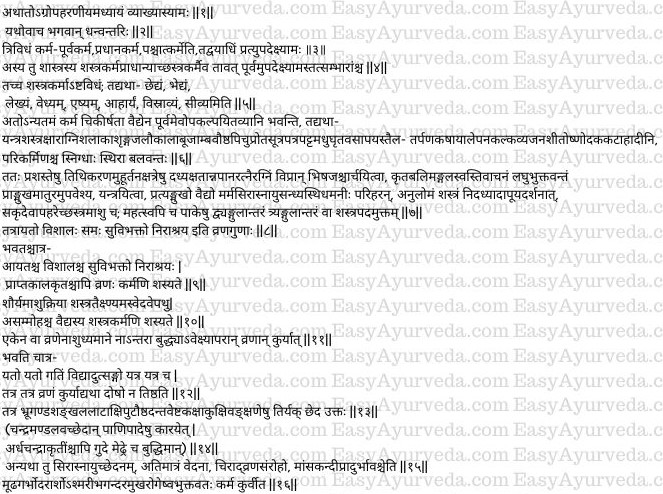
Sanskrit Versus
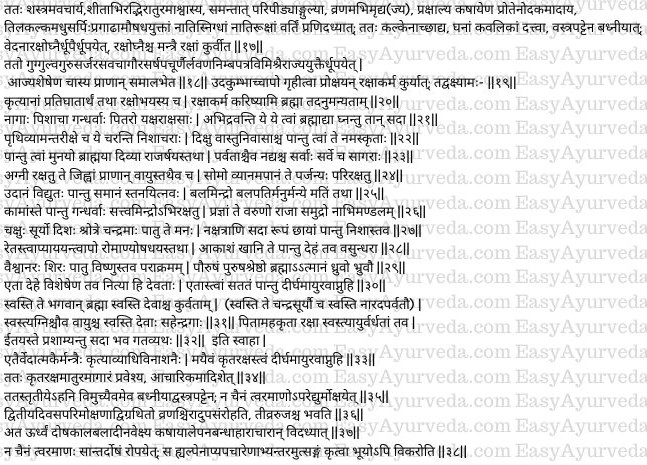
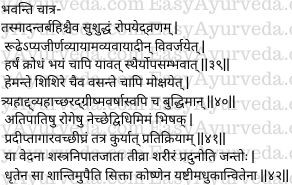
Some verses here: –
Hence, the wound which is clean both inside and outside should be made to heal. Even after healing, the patient should avoid indigestion, physical exercise, copulation, excitement, anger and fear until the wound is completely healed and the patient attains firmness.
The intelligent physician should remove the bandage after three days in Hemanta (dewy, early winter), Sisira (late winter), Vasanta (spring) seasons and after two days in Sarat (autumn), Grisma (summer) and Varsa (rainy) seasons.
In emergency diseases (caused by suppuration in wounds or there is threat to life due to excessive bleeding from the wounds), this procedure need not be followed strictly by the physician and treatments which are urgently required should be done, just as salvaging a house which has caught fire.
That pain, which is produced by the knife, troubles the body of the patient greatly; and gets subsided by application of lukewarm ghee boiled with Yastimadhu (Glycyrrhiza glabra, licorice).
Thus, end the Fifth chapter by name Agropaharaniya – in Sutra Sthana of Susruta Samhita.

